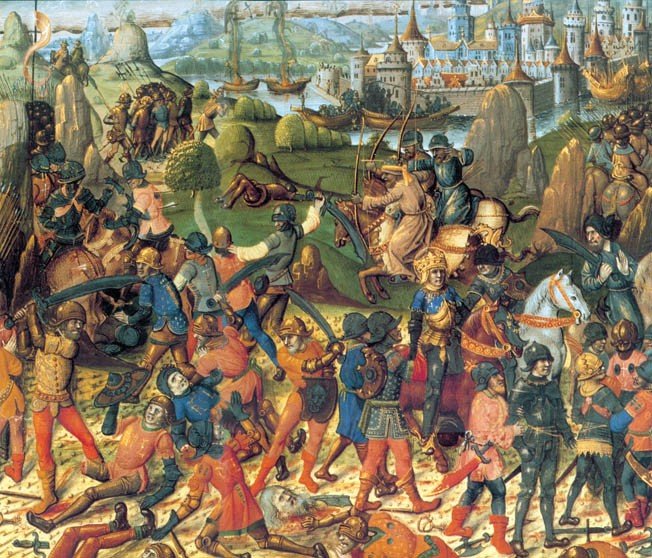Part-III: Rise of Mamluks & the End of the Crusades
By Muhammd Zunair

Unlike Salah ad-Din, his successors relied on the policy of reaction and it gave the Crusaders a chance to regroup themselves and also provided the Church with an opportunity to send another military expedition.
Thus, in 1199, Pope Innocent III — who had already made Crusades a major concern of the Latin Church — called for the Fourth Crusade towards the Eastern Mediterranean.
Fourth Crusade (1199–1204)
Contrary to the first three Crusades, this time the Crusaders were aiming for Egypt, which has now become the center of Muslim power in the region. So, they asked Venetians to provide them the transport and to help them reach Egypt.
Called by Pope Innocent III and led by Boniface of Montferrat, initially the Fourth Crusade was aimed at recapturing of the holy city of Jerusalem. However, driven by political and economic factors, the Fourth Crusade couldn’t achieve its objectives, rather it led to the Sacking of Constantinople in 1204.
When the Crusaders reached Venice, they were only about 12,000 men and they didn’t even have the money to pay Venetiants for transporting them. As a result, they agreed to the offer of Doge Enrico Dandolo — the leader of Venice — and helped him in recapturing the city of Zadar.
After helping Doge in getting the control of Zadar, the Crusaders sailed from Venice with the goal of recapturing the holy city of Jerusalem but they ended up sacking Constantinople.
Sack of Constantinople, 1204

Boniface of Montferrat, who was now leading the Fourth Crusade after the death of Thibaut III of Champagne, had links with the Byzantine Prince, Alexios Angelos, who wanted to topple the Byzantine Emperor, Alexius III. Thus, he wanted to lead the Crusade towards Constantinople.
The Crusade leadership, on the other hand, was riddled with political, economic, and religious factors. Hence, they were left with no option but to divert the Crusade towards Constantinople for putting Alexios Angelos and his father on the throne. Consequently, the Crusaders succeeded and Alexios Angelos became the emperor.
Motivated by economic, political, and religious factors, the leaders of the Fourth Crusade deviated from the original goal and indulged themselves in a fight against the Byzantine Emperors — First, Alexius III, and then Alexius IV.
Thus, the Fourth Crusade, which was called for recapturing of Jerusalem, ended with the fragmentation of the Byzantine Empire — further aggravating the Catholics vs Orthodox divide.
Fifth Crusade (1217–1221)
The failure of the Fourth Crusade in recapturing Jerusalem led to another military expedition — aimed at conquering Cairo and then Jerusalem.
Led by King Andrew II of Hungary and Leopold VI, Duke of Austria, the Crusaders made plans for first getting hold of Egypt and then to liberate Jerusalem from the Ayyubids.
The Crusaders wanted to take control of Egypt because it could’ve resulted in breaking the Muslim rule in the region. Thus, the Crusaders marched forward for capturing the strategic port of Damietta and they succeeded in their mission in 1219.
The Crusaders, however, couldn’t move further for more than a year as they were waiting for the Emperor Frederick II. As Frederick didn’t arrive so, in 1221, it was finally decided to enter Egypt through the port of Damietta and to march towards Cairo.
However, they soon found themselves trapped at Al-Mansoura and Ayyubid Sultan, Al-Kamel, made use of the situation to flood the Crusaders camp. As a result, a large number of Crusaders retreated while a lot of them had to surrender. Consequently, the Fifth Crusade also failed miserably.
Sixth Crusade (1227–1229)
The failure of the Fifth Crusade had to be compensated and it was Emperor Frederick II, who now had the duty of leading another Crusade towards the Eastern Mediterranean.
Nonetheless, Frederick’s issues with the Church delayed this campaign and also resulted in his excommunication. Therefore, it took him almost seven years to lead the Sixth Crusade towards Egypt.
In 1227 — seven years after the failure of the Fifth Crusade — excommunicated King led another military expedition for getting the control of Jerusalem.
Interestingly, this military campaign got converted into a diplomatic mission as several factors were at play. Thus, negotiations started between the Ayyubid Sultan, Al-Kamel, and the emperor, Frederick II.
Later in 1229, an agreement was finally reached, which led to the recapturing of Jerusalem by the Crusaders without a fight or bloodshed. However, the rule couldn’t be sustained because of internal conflicts and external threats.
Moreover, after the expiry of the treaty of 1229, a new power in the Muslim world — The Khwarezmians — emerged and started making moves for the liberation of Jerusalem from the Christian rulers. So, it was a matter of time before Muslims could regain control of Jerusalem.
Seventh Crusade(1248–1254)
In 1244, Muslims recaptured Jerusalem and ended the 15-year long rule of Christians in Jerusalem. As a consequence, King Louis IX of France decided to wage another military expedition — the 7th Crusade — in 1248.
The Seventh Crusade also followed the path of the Fifth Crusade and entered Egypt through the port of Damietta. However, as they reach Al-Mansoura in 1250, the Crusaders had to deal with a new class of opponents — Mamluks.
The Crusaders soon found themselves trapped by the Mamluks, who not only took the King as a prisoner but also killed many knights and nobles. Thus, the Seventh Crusade also fell flat on its face.
The failure of the Seventh Crusade resulted in the cementing Mamluks as the new Muslim power to reckon with. However, for gaining supremacy in the region, Mamluks had to deal with both the remaining Crusaders as well as the imminent threat of Mongols.
Furthermore, this period coincided with the Siege of Baghdad(1258) and the rise of the Mongols as a supreme power in the region. As the Mongols wanted to extend their rule to the shores of the Muslim Levant, they thought of capturing Damascus and Aleppo, which they did in the next two years.
Nevertheless, the remaining part of the Muslim Levant was still under the control of Mamluks. So, the Mongols shifted their attention towards Mamluks and met them in the Battle of Ain Jalut.
Surprisingly, the Mamluks — led by Sultan Qutuz — defeated the Mongols and it gave them a boost to deal with the Crusaders once and for all.
Qutuz, however, was soon killed and Sultan Baibers became the Sultan of the Mamluks. It was him, who now had the responsibility to finally put an end to the Crusades.
Hence, Baibers recaptured most of the region in the Muslim Levant, including the principality of Antioch — one of the remaining strongholds of the Crusaders.
Meanwhile, in Europe, the erosion of the Church had already set in and the sovereign states had already started emerging, which ultimately prevented the Western Church from sending more military expeditions.
In 1291, Acre fell to Muslims and after almost two centuries of constant warfare, geopolitical maneuvering, strategic alliances, and peace agreements, one of the most significant periods in Medieval history — Crusades — finally came to an end.












